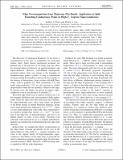Edge Ferromagnetism from Majorana Flat Bands: Application to Split Tunneling-Conductance Peaks in High-T[subscript c] Cuprate Superconductors
Author(s)
Potter, Andrew C.; Lee, Patrick A.
DownloadPotter-2014-Edge ferromagnetism.pdf (320.2Kb)
PUBLISHER_POLICY
Publisher Policy
Article is made available in accordance with the publisher's policy and may be subject to US copyright law. Please refer to the publisher's site for terms of use.
Terms of use
Metadata
Show full item recordAbstract
In mean-field descriptions of nodal d-wave superconductors, generic edges exhibit dispersionless Majorana fermion bands at zero energy. These states give rise to an extensive ground-state degeneracy, and are protected by time-reversal symmetry. We argue that the infinite density of states of these flat bands make them inherently unstable to interactions, and show that repulsive interactions lead to edge ferromagnetism which splits the flat bands. This edge ferromagnetism offers an explanation for the observation of the splitting of zero-bias peaks in edge tunneling in high-T[subscript c] cuprate superconductors. We argue that this mechanism for splitting is more likely than previously proposed scenarios and describe its experimental consequences.
Date issued
2014-03Department
Massachusetts Institute of Technology. Department of PhysicsJournal
Physical Review Letters
Publisher
American Physical Society
Citation
Potter, Andrew C., and Patrick A. Lee. “Edge Ferromagnetism from Majorana Flat Bands: Application to Split Tunneling-Conductance Peaks in High-T[subscript c] Cuprate Superconductors.” Physical Review Letters 112, no. 11 (March 2014). © 2014 American Physical Society
Version: Final published version
ISSN
0031-9007
1079-7114